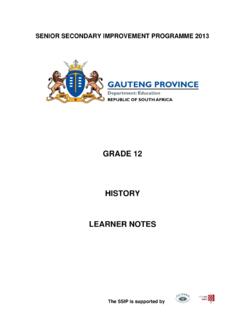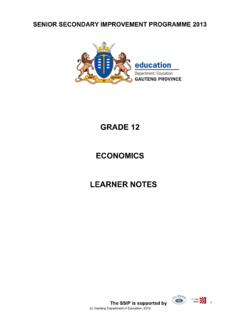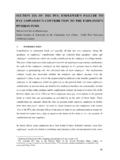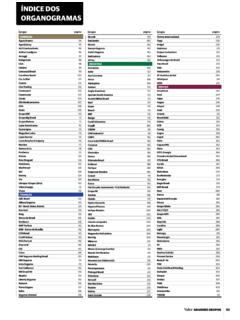Transcription of GRADE 12 ECONOMICS TEACHER NOTES - Mail & Guardian
1 The SSIP is supported by SENIOR SECONDARY INTERVENTION PROGRAMME 2013 GRADE 12 ECONOMICS TEACHER NOTES Page 2 of 119 TABLE OF CONTENTS TEACHER NOTES SESSION TOPIC PAGE 1 Topic 1. Circular flow Topic 2. The multiplier 3 16 2 Topic 1. Business cycle composition and reasons Topic 2. Government policy and forcasting for business cycles 17 - 27 3 Topic 1. Necessity of public sector and problems of public sector provisions Topic 2. Fiscal policy, laffer curve and public sector failure 28 - 39 4 Topic 1. Perfect market cost and revenue curves Topic 2. Profit maximising in a perfect market 40 49 4 Self Study: Topic 1. Imperfect market - monopoly Topic 2. Imperfect market oligopoly 50 58 5 Topic 1. Market failure Topic 2. Cost benifit analysis 59 67 6 Topic 1.
2 economic growth and development Topic 2. North-south divide 68 76 6 Self Study: Topic 1. South Africa s industrial development policies Topic 2. Free trade and protectionism Topic 3. Import substitution and export promotion 77 - 91 7 Topic 1. Balance of payments Topic 2. Foreign exchange market 92 104 7 Self Study: Topic 1. economic Indicators Topic 2. Social Indicators 105 119 GAUTENG DEPARTMENT OF EDUCATION SENIOR SECONDARY INTERVENTION PROGRAMME ECONOMICS GRADE 12 SESSION 1 ( TEACHER NOTES ) Page 3 of 119 TOPIC 1: CIRCULAR FLOW TOPIC 2: THE MULTIPLIER TEACHER Note: Make sure you explain the circular flow model and how to use it to work out the value of the output produced by the economy at factor cost. Also remember that when Leakages = Injections the economy will be in equilibrium.
3 Point out how changes in the injections cause a change in the equilibrium level of output. LESSON OVERVIEW 1. Briefly introduce the cicular flow/multiplier: 10 minutes 2. Learners answer the questions: 45 minutes 3. Go through Solutions and Hints with the learners: 30 minutes 4. Preview Homework Questions 5 minutes SECTION A: TYPICAL EXAM QUESTIONS: TOPIC 1: CIRCULAR FLOW QUESTION 1: 12 minutes (Taken from DoE Nov 2009) Study the table below on the calculation of GDP and answer the questions that follow. CALCULATION OF GDP ACCORDING TO THE INCOME METHOD (2007 figures) R bn. Compensation of employees .. Net operating surplus .. Consumption of fixed capital .. Gross value added @ _____ A_____ Taxes on production .. Subsidies on production.
4 Gross value added @ basic prices .. __C____ on products .. Subsidies on products .. Gross domestic product @ market prices .. Primary income from rest of world .. Primary income to rest of world .. GNI @ market prices .. 843 644 _ _255 1 742 35 _ _6 B 231 _____6 1 996 46 _____108 1 934 [Source: SARB Quarterly Bulletin, September 2008] Differentiate between GDP and GNP. (4) (Define both GDP and GNP) Which alternative term is used for GDP in the national accounts? (2) (Alternative name) Provide labels for A and C. (4) Calculate the gross value added at basic prices (letter B). (4) Which component contributed most to the Gross Domestic Product? (3) (Use data in table) GAUTENG DEPARTMENT OF EDUCATION SENIOR SECONDARY INTERVENTION PROGRAMME ECONOMICS GRADE 12 SESSION 1 ( TEACHER NOTES ) Page 4 of 119 Give a reason why the GNP figures in South Africa are generally lower than the GDP figures.
5 (3) [20] QUESTION 2: 20 minutes (Taken from DoE Nov 2008) An open economy circular flow model illustrates the economic interaction between the four participants. Describe this interaction in detail with the aid of a diagram, which includes injections and withdrawals. [35] (This question is only part of an essay question that counts 50) QUESTION 3: 13 minutes (Taken from DoE Nov 2010) Explain leakages and injections. (8)) (Remember always to give an example) List THREE methods by which the gross domestic product can be calculated. (3 x 2) (6) Discuss the role of households (consumers) in the economic circular flow model. (4 x 2) (8) [22] QUESTION 4: 6 minutes (Taken from DoE Nov 2010) Study the table below and answer the questions that follow.
6 Explain the item subsidies on products. (3) Explain the item consumption of fixed capital. (3) Calculate the compensation of employees as a percentage of GDP at market prices. Show ALL calculations. (4) [10] GAUTENG DEPARTMENT OF EDUCATION SENIOR SECONDARY INTERVENTION PROGRAMME ECONOMICS GRADE 12 SESSION 1 ( TEACHER NOTES ) Page 5 of 119 TOPIC 2: THE MULTIPLIER QUESTION 1: 12 minutes (Taken from DoE Exemplar 2008) Study the graph below that depicts a simplified two-sector economy (where E = C + I) and answer the questions that follow. Name the TWO sectors involved in deriving the macro- economic multiplier. (4) (Name means to give only the terms and not discuss them.)
7 What is represented by the line E = Y? (4) Use the formula, k = Y/ J, to calculate the multiplier (k) for the above scenario. (4) (Remember that Y = the change in Income, and that J = the change in Injections.) Calculate the multiplier, using the formula, k = 1/(1 MPC), when the marginal propensity to consume (MPC) = Show calculations. (6) Explain the relationship between the MPC and the multiplier. (2) (Relationship is how they affect one another.) [20] GAUTENG DEPARTMENT OF EDUCATION SENIOR SECONDARY INTERVENTION PROGRAMME ECONOMICS GRADE 12 SESSION 1 ( TEACHER NOTES ) Page 6 of 119 QUESTION 2: 10 minutes (Taken from DoE Feb/March 2009) Copy the graph below.
8 Indicate the new consumption curve, new equilibrium formed after investment increased by R20 million, and describe the multiplier effect of the increase of investment of R20 million on the economy. [16] (Remember to copy the graph as is, because you will be indicating the change on the graph. Calculate the multiplier first. Show your new formula with an increase of R20 million.) QUESTION 3: 12 minutes (Taken from DoE Feb/March 2010) Study the graph of the multiplier in a two-sector model where the consumption function is given by C = c + c(Y) on the following page, and answer the questions that follow. GAUTENG DEPARTMENT OF EDUCATION SENIOR SECONDARY INTERVENTION PROGRAMME ECONOMICS GRADE 12 SESSION 1 ( TEACHER NOTES ) Page 7 of 119 Define the term multiplier.
9 (3) (Define means writing out the whole definition.) With reference to the graph, name the TWO sectors involved in deriving the macro- economic multiplier. (4) (Please look at graph to identify the two sectors; don t name any other.) Indicate what is represented by the dotted line. (2) What is the value of autonomous consumption for the original consumption function? (2) (It is only 2 marks; therefore, you don t have to show any calculations.) Suppose the marginal propensity to save (MPS) = 0,4. Use the multiplier formula to calculate the eventual change in aggregate income, if there was an injection of R10 billion into the economy. Show ALL the calculations. (HINT: Determine the size of the multiplier first.)
10 (6) Describe the relationship between the MPC and the multiplier. (3) [20] GAUTENG DEPARTMENT OF EDUCATION SENIOR SECONDARY INTERVENTION PROGRAMME ECONOMICS GRADE 12 SESSION 1 ( TEACHER NOTES ) Page 8 of 119 SECTION B: SOLUTIONS AND HINTS TO SECTION A: TOPIC CIRCULAR FLOW QUESTION 1: 12 minutes (Taken from DoE Nov 2009) GDP is total value of final goods and services produced within the boundaries/borders of a country for a specified period. GNP is total value of final goods and services produced by the (4) Gross Value Added (2) A = factor cost C = taxes (4) R1 742 bn. + R35 bn. R6 bn. = R1 771 bn. OR R1 771 bn. / 1 771 (4) Compensation of employees (3) Foreigners contribute more to our economy than we do to their economy, therefore a greater amount is subtracted from the GDP and less is added.

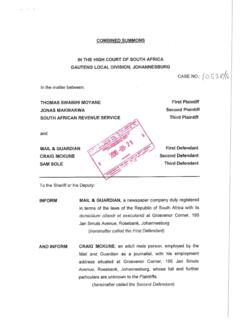
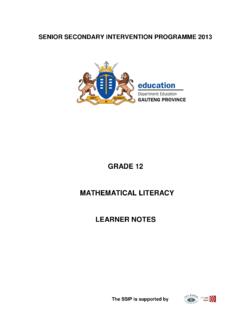
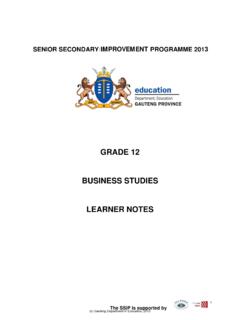
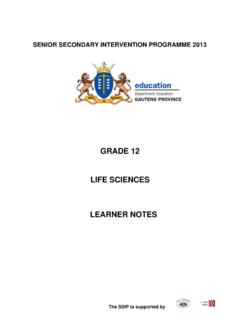

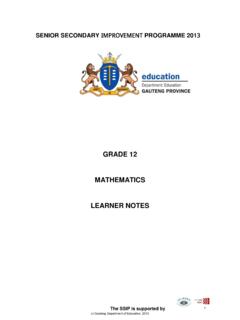
![FORM B NOTICE OF INTERNAL APPEAL [Regulation 8]](/cache/preview/a/0/a/7/3/c/7/0/thumb-a0a73c70e115f1c5cc7bd639b8e458e6.jpg)
